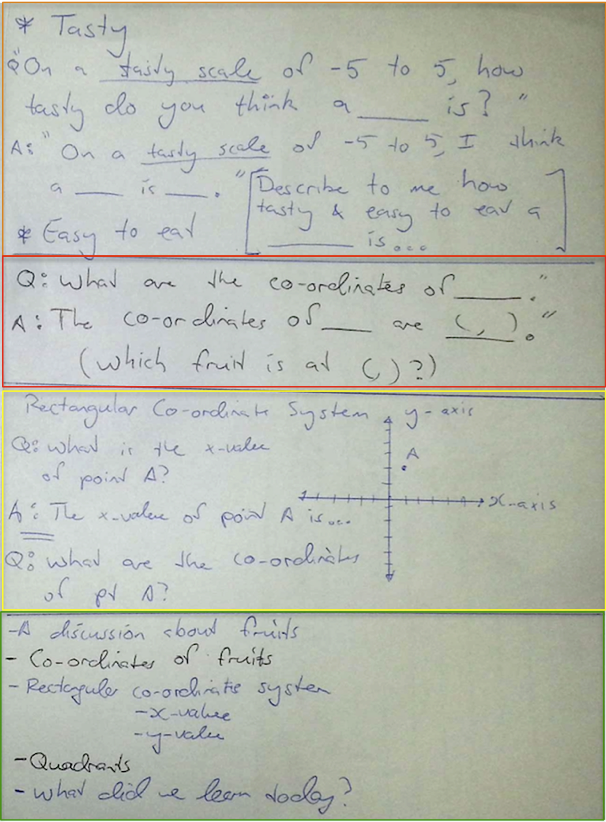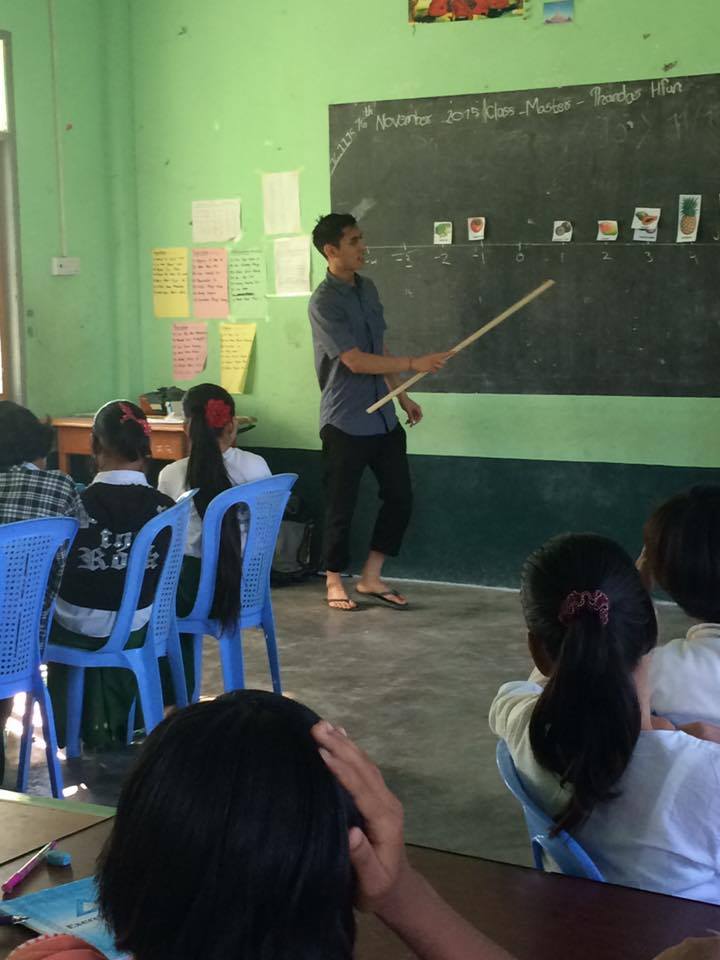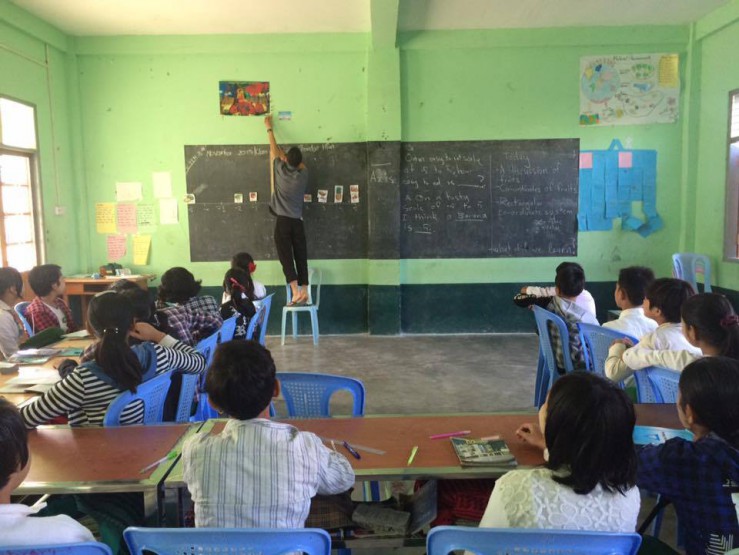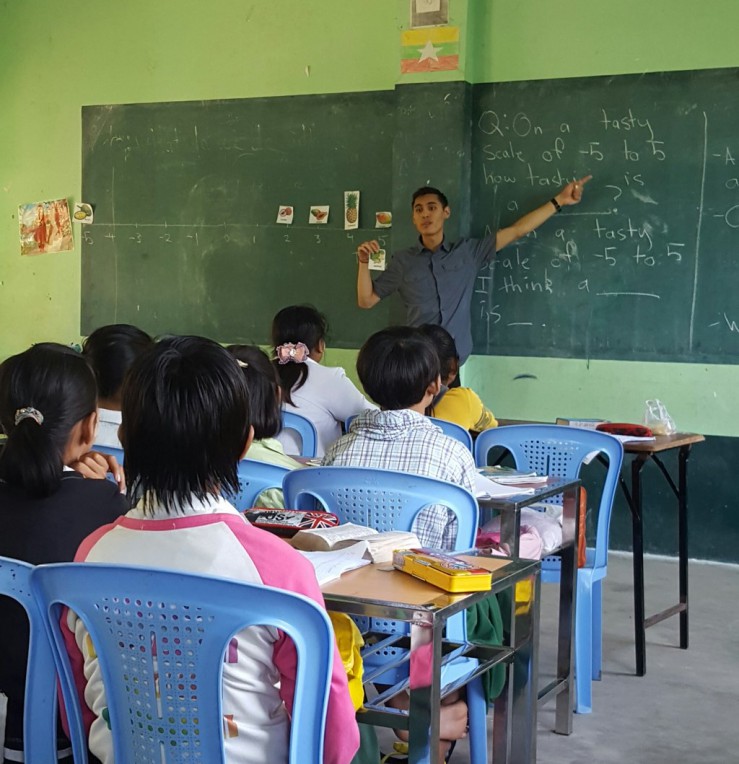Edit: Desmos has now come out with an interactive activity that introduces coordinate planes in the manner outlined below. Check it out here.
On November the 8th, whilst millions of excited Burmese voters headed to the polls, I arrived bleary-eyed and hungry from an overnight bus ride in Myanmar’s second largest city, Mandalay. Along with 9 other pre-service teachers and our two group leaders, I was about to start a two week teaching placement at the Phaung Daw Oo Monastic School.
This post is about what I learned from that two week placement. I’ve chosen to present it through the ‘case study’ of adapting a lesson on Cartesian co-ordinates from the Australian to the Burmese context. I feel that the process of adaptation provides a good framework for me to discuss and explore my two main learnings from the trip, one on the use of language in the classroom, and the other on modelling.
The genesis for this lesson was in August of 2014 when I was lucky enough to attend a Dan Meyer workshop at the Love Learning Conference in Sydney. Dan introduced attendees to a ‘fruitful' approach to introducing Cartesian co-ordinates to students. Almost exactly a year after that first workshop, I used a very similar approach in the first lesson of my second placement with a class of year 9 students.
The following video shows how I did it in Aus[1].
Fruit Slideshow (in case you'd like to use all or part of it in your class)
Students appeared really engaged in this approach. They loved the debates about who was better at describing things, and about which fruit was tastier or ‘easier’ than the other. Upon leaving one student remarked, “That was a really good lesson, sir.”
When I arrived in Myanmar and my associate teacher, Thanta, told me that it would be good if I could do some lessons on Cartesian co-ordinates (she called them rectangular co-ordinates), this introduction seemed an obvious choice[2]. The task became, how to adapt it to the local context? There were three main challenges that I anticipated.
- Would students understand the concept of ‘rating scales’?
- Very limited English
- No electricity
Addressing challenge #1 – Rating scales:
This wasn’t too hard. It required me pacing the ‘Tasty’ spectrum (I altered it to go from -5 to 5 to make it clearer on the blackboard) and miming delicious at one end (rubbing stomach and making contented chewing sounds) vs. disgusting at the other (pretending to be sick). Then doing this a few more times. That was the easy part…
Addressing challenge #2 – Very limited English:
The first big lesson for me from this placement came through the challenge of surmounting the language barrier. To give you an idea of the level of English competency of my classes, if I asked ‘Please get your books out and write this down’, about half of the class would understand the instruction and begin, and the other half would copy the half that understood. This is where I was able to explore, in context, the concept of CLIL (Content and Language Integrated Learning). What CLIL means in a maths class is that the goal of every lesson isn’t just to teach maths concepts, but to simultaneously teach maths concepts as well as the language required to understand and talk about them.
Here’s what my lesson plan for the Myanmar fruit lesson looked like…
The green box down the bottom was the text I put on the board to help structure the lesson (note: It was way too ambitious, we only made it to ‘rectangular co-ordinate systems’).
Orange box up top represents the sentence that I wrote on the board to introduce the idea of a ‘scale’ to students.
You’ll note I changed the y-axis title from ‘easy’ to ‘easy to eat’ to reduce ambiguity.
More broadly, I adopted the Q:, A:, format that permeates the lesson plan as a way to teach students that I wanted students to answer in full sentences (related to the CLIL approach). They were quite strong with their numbers, for example, if I asked ‘How tasty is a pineapple’ they would be quite confident saying ‘minus 5[3]’ but saying ‘On a tasty scale of -5 to 5, I think a pineapple is -5[4]’ was a serious challenge for all but a few of them. Through this challenge, and the placement more generally, I became aware of the importance of scaffolding the language needed to express the ideas. As can be seen, this whole lesson plan is structured around supporting the students to employ a few basic sentences, inclusive of key vocabulary, to communicate the mathematical ideas. For me this was a real revelation and an approach that I’ll definitely be taking into classes in future. In the past I’ve expected students to be able to replicate the language that I use, and to intuitively employ the relevant metalanguage. But this just isn’t realistic. Only by reflecting back on my Australia-based placements through this new CLIL lense have I been able to understand how much of a barrier language was for my students here, and how a language-conscious approach to teaching them would have helped so much more. Every question a student answers is an opportunity to encourage them to employ your discipline-specific metalanguage.
Addressing challenge #3 – No electricity (and foreign fruit):
Pictures help. Here’s how I tackled this one…
Photographer: Gabriella Sabatino
Photographer: Gabriella Sabatino
Photographer: Kira Clarke
Printed out tropical fruits, with the english names on them, and a bit of elephant snot (blu-tac) did the trick. If you look closely at the board you can see the sentences from the lesson plan’s green and red boxes there.
And just in case, here’s the PDF of the fruit in-case you ever find yourself teaching co-ordinate systems in a tropical area.
This brings me to my second big lesson from the placement, Modelling. The electronic approach that I used in the Aussie context was great for a few reasons. It was clear and easy for students to see, it was quick and enabled me to move through the lesson efficiently, and it was dynamic and enabled for quick transitions between tasks. But it had one major flaw. My axes just ‘appeared’ on the screen. This has ramifications related to board and book work more generally.
Traditionally my board work has been pretty atrocious. Focussing on the clarity of my digital presentations, I’d often free-drawn my axes and scribble working all over the board in random spots that I found free. In the words of one of our team leaders ‘Everything you do is modelling’. I hadn’t thought about this before and hadn’t noticed the intrinsic contradiction of my unstructured board work and my expectations for students to be neat with their book work. This also passes up opportunities to discuss some of the key elements of tasks like drawing axes: deciding how far apart to set your numbers and leaving space for axis and chart titles.
The thing that really drove this modelling lesson home for me was the language barrier. There was no way that I could rely on scribbling something up on the board and the verbally explaining to students the key points and the ‘don’t forgets’. That would just be met with blank faces (as it was in my first lesson…). Against the backdrop of this linguistic challenge, the importance of modelling was made undeniably obvious to me.
Summary of key lessons:
This post has really been a combination of two. One on what I have found to be an engaging approach to introducing Cartesian co-ordinates to students, and the other on two key lessons that I learned through the process of adapting this approach for a group of students in Myanmar.
The first key lesson was the importance of CLIL (Content and Language Integrated Learning). In the same way that this blog post has introduced the term CLIL to readers (I’m assuming it’s new for at least some readers) at the same time as introducing the concept itself, I will in future strive to better scaffold and explicitly teach the linguistic skills required by my students, in conjunction with the teaching of concepts.
Secondly, I’ve come to appreciate the value and importance of clear modelling in the classroom. This is important for all students, but especially for those who have English as an additional language or auditory processing challenges[5].
In a recent speech that I gave at the Australian College of Educators Media Awards, I spoke about how stepping into different realms can often bring the most important lessons and opportunities for innovation. For me, this Myanmar teaching placement brought this assertion home more profoundly than I could have expected. The chance to teach in such a different setting, and with such a supportive team[6], was the catalyst needed to bring me back to basics and strengthen some of the core foundations of my teaching praxis. I was able to consolidate many of the lessons learned in this first year of my Masters, and I look forward to continuing this fascinating journey through my teaching and research project next year.
For Dan’s very short mention of the fruit salad activity, check out this post (scroll down to ‘Anyway. Part 1’). His posts on personality co-ordinates and this one on co-ordinate battleships are also definitely worth a look!
A big thank you to fellow Maths teacher Dot Yung for her edits and suggestions during the writing of this blog post : )
[1] I recognise that using the binaries of ‘boys’ and ‘girls’ could be exclusionary to some more gender diverse students. In future I will choose non-gendered categories for such an exercise. Check out the work of the safe schools coalition for more on this.
[2] I only adapted the core ‘fruit salad’ element of the lesson and not the dot related introduction.
[3] I would usually teach students to say ‘negative five’ but being there for only 2 weeks and knowing they’d return to ‘minus 5’ after my departure I didn’t bother to insist on the change of terminology.
[4] Pineapples are DEFINITELY not -5 on a tasty scale of -5 to 5… Unless they’re not that ripe, in which case I find that they give me ulcers…
[5] If you’re keen to experiment with the importance of modelling in your own classroom, I came up with the idea of challenging teachers to teach a lesson in silence! Please let me know if you decide to take this challenge on!!
[6] Every class that I taught was observed by another teacher who gave me feedback and suggestions for improvement. This post has underplayed the importance of the ‘instructional rounds’ approach taken by the team, and the impact that that had on all of our teaching. The opportunity to have my own lesson critiqued as well as analyse other teachers’ lessons, and hear what was seen through other people’s eyes, was invaluable beyond my expectations. This instructional rounds approach is a process that I hope to learn more about and do more in future. As a starting point I plan to read the article: Ensuring Instruction Changes: Evidence Based Teaching–How Can Lesson Study Inform Coaching, Instructional Rounds and Learning Walks?




@ollie_lovell Great blog post! I’ve passed it on to the MGSE media team.
@ddmeyer. Here’s your fruit salad co-ordinates lesson as I taught it in Australia and then Myanmar! https://t.co/6dRWaHSrS7 #mathchat
Great #PST reflections on fruit salad co-ordinates lesson in Oz & Myanmar https://t.co/fCcLNCkXHP #MAVCON Well done @ollie_lovell
RT @brittgow: Great #PST reflections on fruit salad co-ordinates lesson in Oz & Myanmar https://t.co/fCcLNCkXHP #MAVCON Well done @ollie_lo…